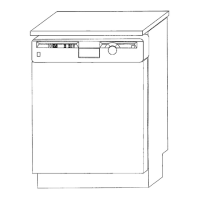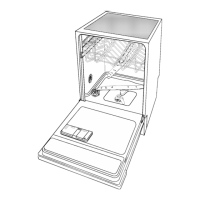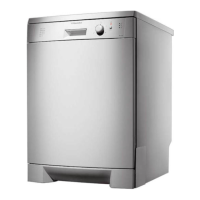The following components are fitted to the base:
1. SUMP ASSEMBLY:
The sump is a container fitted with special ducts which collect and distribute the water for washing the
dishes.
The sump is connected by a series of ducts to the IWMS, the feed ducts to the two spray arms, and
the drain outlet.
2. SALT TANK:
The salt tank contains the salt which is used during the regeneration cycle
The salt tank is connected hydraulically to the IWMS.
3. RESIN WASHING TANK:
This tank contains the water which is collected during the regeneration and resin washing cycles, and
is connected hydraulically to the IWMS.
The circuits which connect the various components are fitted with special valves designed to guarantee the
efficiency and performance of the system.
4. BREATHER VALVE FOR RESIN WASHING TANK:
This float-type valve is fitted to the resin washing tank (underneath the tub).
The valve has two functions:
- To open the breather valve of the tank during the regeneration cycle in order to allow the salt-filled
water to enter the tank
- To close the breather valve during the drain cycle in order to guarantee maximum efficiency of the
pump (time required to drain the tank: 30 seconds).
5. RESIN WASHING TANK SEPARATOR VALVE:
This floating-ball valve is fitted to the exterior of the sump, and is connected by a duct to the resin
washing tank.
The function of this valve is to separate the salty water contained in the resin washing tank from the
softened washing water.
6. SUMP BOTTOM VALVE:
This is a floating-ball valve located inside the sump.
The valve has two functions:
- To separate the water in the washing circuit from the drain water during the washing cycle
- During the drain cycle, to ensure that the sump is drained even if the filtering system or periscope
are not fully efficient.
7. NON-RETURN VALVE (normally-closed type):
The membrane-type non-return valve is fitted to the exterior of the sump and connected directly to the
drain outlet.
Its function is to ensure that the water in the tub is kept separate from the external water supply circuit.
In effect, this valve prevents the water outside the appliance (from the sink, siphon etc.) from entering
the tub through the drain hose.
At the end of the drain phase, it also reduces the quantity of residual water remaining in the sump.
- 13 -

